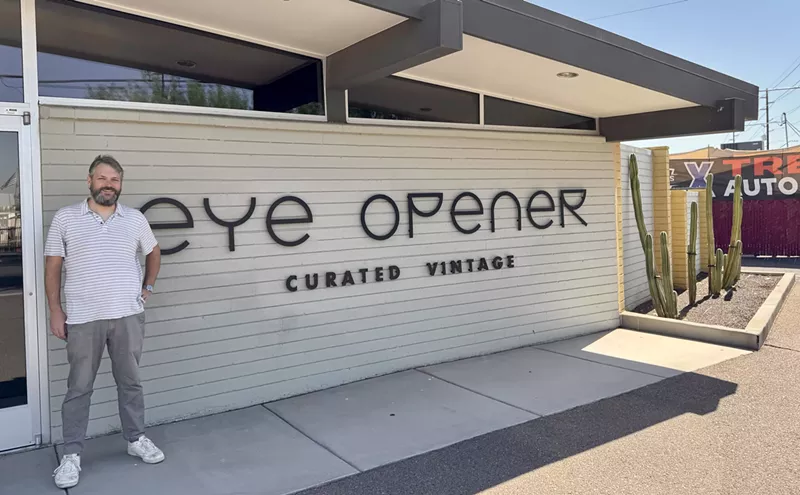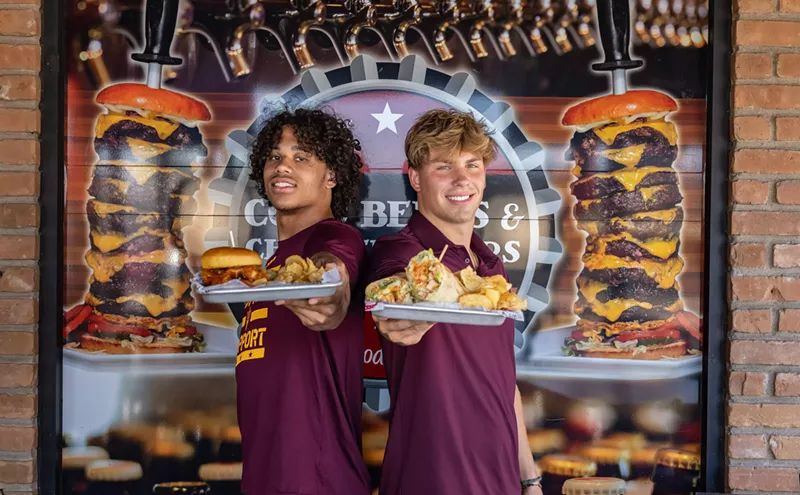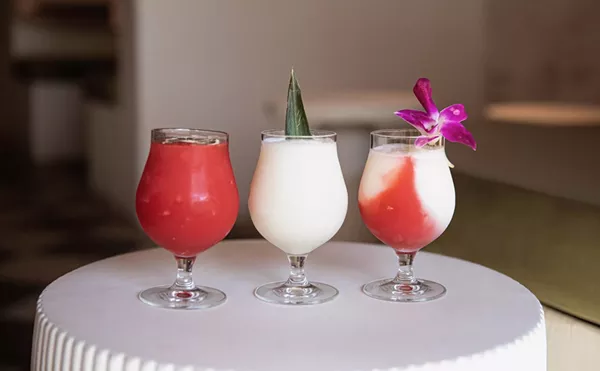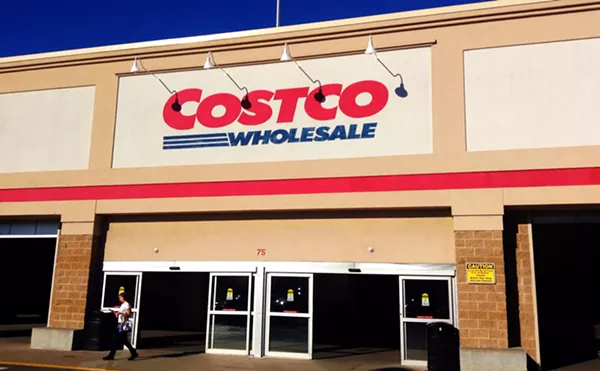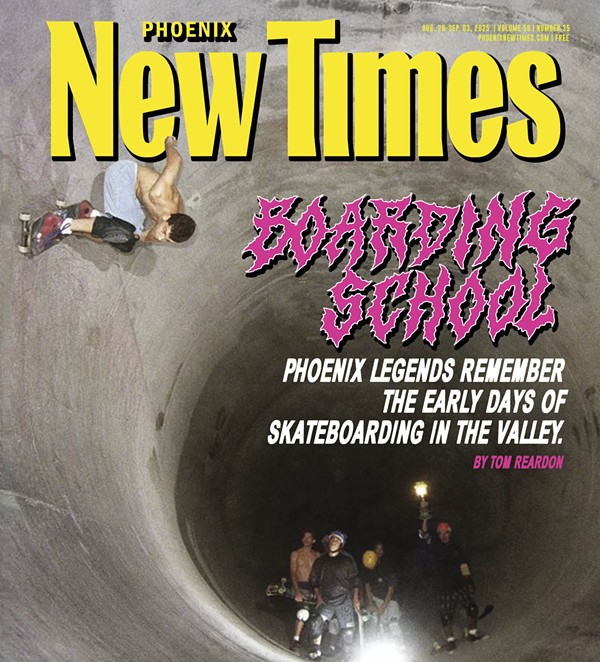This is not because I have any special fondness for Tucson in general, lovely town though it is. No, the attraction for me is specific -- any excuse will serve to eat at El Charro Cafe on Court Street, my favorite Mexican restaurant. I suspect it may be the greatest Mexican restaurant in the U.S. It may be the greatest in the world.
Tom Miller's opinion is milder. "This is a good joint," he says. "It's not my favorite in town, but it's a good joint." I forgive him the sacrilege of applying the term "joint" to so exalted a culinary temple as El Charro only because he's written warmly of it in the past, in the book he co-authored, Interstate Gourmet: Texas and the Southwest. The "joint" is also mentioned, by name, on page 79 of Miller's new book, Jack Ruby's Kitchen Sink.
It may be that Miller had an angle on the restaurant that didn't allow him to become as entranced as I am. "For a few years, I rented office space immediately behind this building," he says. "I could see the cage on the roof that they dry the carne seca in from my desk. I didn't come here that often, but it came to me. Every morning they put it in there, and by 10 or 10:30, the smell was strong."
Nevertheless, it's this renowned house specialty, the carne seca ("dry meat") combination, that we both order. Then Miller turns to the subject of the city I've driven down from. On his way to lunch, he'd been thinking of one of the Phoenix area's most illustrious citizens -- Randy Johnson. "He looks like some homeless guy down on Grand Avenue," Miller observes. "I was just down at the library, and there was a whole gang of Randy Johnsons out front. In every city, there's a cluster of Randy Johnsons, usually in front of the public library." Urban phenomena like this, especially if they concern the Southwest, fascinate Tom Miller.
He wonders aloud, for instance, "Why is the poor side of town either west of the railroad tracks or south of the railroad tracks? I'd be willing for somebody to get an NEH grant to figure it out. Would you like an NEH grant?" he asks the waiter, who has approached our table. He explains his sociological question to the young man, who hasn't a clue what we're talking about. "It was worth asking him, though," Miller says after the guy politely declines the NEH grant and leaves. "'Cause he might have had the answer."
He doesn't, but he does bring us our soup. It's the week of Thanksgiving, and El Charro has added the appropriately autumnal touch of pumpkin soup, served with cinnamon and sugar crispies in lieu of crackers. As we eat the pleasing, orange-brown, lightly sweet concoction, Miller tells me how he ended up in Tucson.
A Washington, D.C., native, Miller's first westward leap had been to College of Wooster in Wooster, Ohio. "When I studied, I studied political science, but it was also the beginning of the anti-war movement, '65 and '66, and I studied that more than my classes. And I worked for the college paper." He left school after two years. "Shame of the cities, I've never gotten a college degree," he says.
He continued to work for college newspapers, though, writing for the College Press Service, and also for the then-thriving underground press. Before long, he headed still farther west. "I spent the early summer of '69 hitchhiking through Mexico, and made a point of ending up here," he recalls. "I knew nothing about it except that Barry Goldwater and marijuana both come from Arizona, and I thought, that's an intriguing area. And, I wanted to get as far away from the East Coast as I could."
For a journalist of his interests, Arizona was virgin territory. "At that time in the underground press, there was lots of coverage coming out of major cities, you know, Berkeley, Chicago, but not much out of secondary cities. And it wasn't for lack of activity -- there was actually a very strong anti-war movement here [in Tucson] -- but for lack of anybody to write about it."
Ever since, Miller, who counts among his influences Moritz Thomsen, Paul Krassner, Andrew Kopkind and the Firesign Theatre, has poured out swift, readable, lightly funny nonfiction for publications ranging from the New York Times to Rolling Stone to the one you're reading now. He's also written volumes -- quite literally -- on Latin America, notably Cuba in Trading With the Enemy and Ecuador in The Panama Hat Trail.
His latest, Jack Ruby's Kitchen Sink, is a collection of essays about the Southwest, on subjects ranging from populist films such as Salt of the Earth and The Milagro Beanfield War to velvet art to the true story of the Valley man killed by the saguaro he was using for target practice. He -- Miller, that is, not the saguaro-shooter -- will be here in the Valley, signing this tome, from 7 to 9 p.m. Thursday, December 14, at Borders Books & Music at 4555 East Cactus.
Our combination plates arrive, in all their splendor -- a copious mound of the shredded, exquisitely arid meat, with rice, beans, guacamole and tortillas. As I attack mine, I ask Miller what his book's overriding theme is. "That the Southwest ain't what you think it is," he replies. "People think it's Georgia O'Keeffe. People think it's cow skulls and velvet art and bola ties. Which it is. But how it got to be those things, and how those things are made and marketed, runs contrary to the whole cowboy image. Anybody who's a journalist out here in this part of the country knows, when you talk to an editor back East, they want to hear the clomping of horses' hooves when you do a piece."
And the peculiar title? "In 1972 I attended an auction of all the fixtures from the Carousel Club," he explains. It was one of the first events that demonstrated the market for morbid Kennedy memorabilia. Miller did not buy the title fixture that day, but he did come away with a prize: "Jack Ruby's can opener is wrapped in a shammy cloth. It's in a Bank of America safe-deposit box on North Campbell Avenue. I paid a dollar for it; I suspect it's doubled in value, at least. If I put it on eBay, I wonder . . ."



